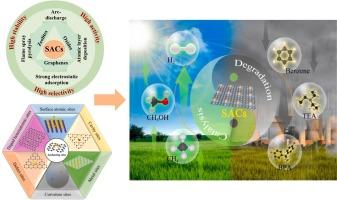Single atoms in environmental catalysis: Breakthroughs in synthesis and application
IF 6.3
2区 工程技术
Q1 ENGINEERING, CHEMICAL
引用次数: 0
Abstract
Due to their outstanding catalytic properties of high stability, high selectivity, and high activity, single-atom catalysts (SACs) have attracted the attention of research teams worldwide. The synthesis and application breakthroughs of single atom in environmental catalysis have been systematically reviewed in this study. With nearly 100 % atomic utilization and easy separation, single-atom catalysts take into account the advantages of homogeneous and heterogeneous catalysts. The results show that the common preparation methods of monatomic catalysts include arc discharge, strong electrostatic adsorption (SEA), flame spray pyrolysis (FSP) and atomic layer deposition (ALD). Common single-atom catalyst supports include graphene, zeolites, and oxides. Common anchoring sites for single-atom catalysts include surface atomic sites, doped heteroatom sites, hole sites, defect sites, metal sites, and curvature sites. In addition, this study also reviewed the application of single-atom catalysts in the field of environmental catalysis, focusing on the breakthroughs of single-atom catalysis in solving volatile organic compounds (VOCs) emission control, activating peroxymonosulfate (PMS) to degrade pollutants, and green energy conversion (GNC). The results show that coordination number and orbital interactions play an important role in the catalytic mechanism of single-atom catalysts. This review indicates that single-atom catalysts have broad application prospects in areas such as air pollution, water pollution, and energy conversion. In addition, the cost, lifespan, loading rate, and secondary pollution of single-atom catalysts will still be issues that require special attention in the future.

环境催化中的单原子:合成与应用方面的突破
单原子催化剂(SACs)以其高稳定性、高选择性和高活性等突出的催化特性吸引了全球研究团队的关注。本研究系统综述了单原子在环境催化中的合成和应用突破。单原子催化剂的原子利用率接近 100%,且易于分离,兼顾了均相催化剂和异相催化剂的优点。研究结果表明,常见的单原子催化剂制备方法包括电弧放电、强静电吸附(SEA)、火焰喷射热解(FSP)和原子层沉积(ALD)。常见的单原子催化剂载体包括石墨烯、沸石和氧化物。单原子催化剂的常见锚定位点包括表面原子位点、掺杂杂原子位点、空穴位点、缺陷位点、金属位点和曲率位点。此外,本研究还综述了单原子催化剂在环境催化领域的应用,重点研究了单原子催化在解决挥发性有机化合物(VOCs)排放控制、活化过一硫酸盐(PMS)降解污染物以及绿色能源转换(GNC)等方面的突破。研究结果表明,配位数和轨道相互作用在单原子催化剂的催化机理中发挥着重要作用。综述表明,单原子催化剂在空气污染、水污染和能源转换等领域具有广阔的应用前景。此外,单原子催化剂的成本、寿命、负载率和二次污染等问题仍是未来需要特别关注的问题。
本文章由计算机程序翻译,如有差异,请以英文原文为准。
求助全文
约1分钟内获得全文
求助全文
来源期刊

Journal of water process engineering
Biochemistry, Genetics and Molecular Biology-Biotechnology
CiteScore
10.70
自引率
8.60%
发文量
846
审稿时长
24 days
期刊介绍:
The Journal of Water Process Engineering aims to publish refereed, high-quality research papers with significant novelty and impact in all areas of the engineering of water and wastewater processing . Papers on advanced and novel treatment processes and technologies are particularly welcome. The Journal considers papers in areas such as nanotechnology and biotechnology applications in water, novel oxidation and separation processes, membrane processes (except those for desalination) , catalytic processes for the removal of water contaminants, sustainable processes, water reuse and recycling, water use and wastewater minimization, integrated/hybrid technology, process modeling of water treatment and novel treatment processes. Submissions on the subject of adsorbents, including standard measurements of adsorption kinetics and equilibrium will only be considered if there is a genuine case for novelty and contribution, for example highly novel, sustainable adsorbents and their use: papers on activated carbon-type materials derived from natural matter, or surfactant-modified clays and related minerals, would not fulfil this criterion. The Journal particularly welcomes contributions involving environmentally, economically and socially sustainable technology for water treatment, including those which are energy-efficient, with minimal or no chemical consumption, and capable of water recycling and reuse that minimizes the direct disposal of wastewater to the aquatic environment. Papers that describe novel ideas for solving issues related to water quality and availability are also welcome, as are those that show the transfer of techniques from other disciplines. The Journal will consider papers dealing with processes for various water matrices including drinking water (except desalination), domestic, urban and industrial wastewaters, in addition to their residues. It is expected that the journal will be of particular relevance to chemical and process engineers working in the field. The Journal welcomes Full Text papers, Short Communications, State-of-the-Art Reviews and Letters to Editors and Case Studies
 求助内容:
求助内容: 应助结果提醒方式:
应助结果提醒方式:


